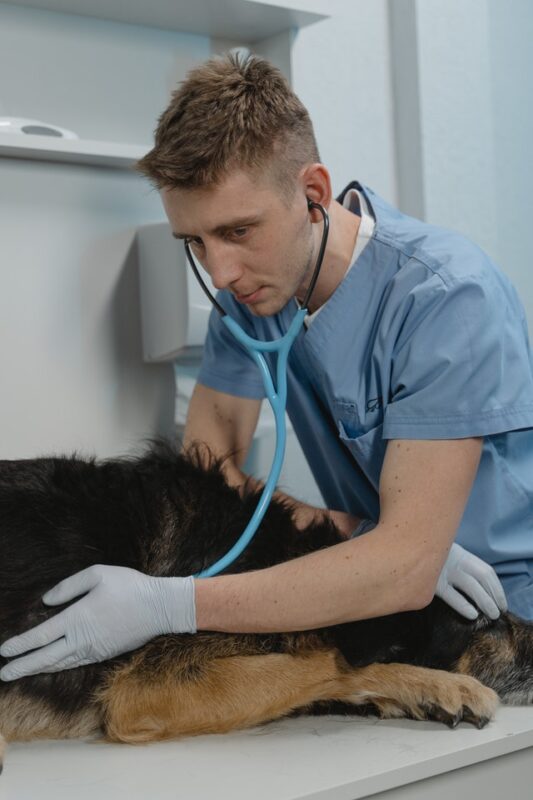Pet Insurance Review > Pet Wellness Guides > 7 Signs Your Dog is in Pain - Pet Insurance Review
7 Signs Your Dog is in Pain
Posted: 07/06/2022 | BY: Jenna Bruce | Categories: Dog , Health problems , Pet care
When it comes to pain, human beings aren’t very stoic. If our back feels achy, we tell everyone who will listen. When we get a headache, we make sure everyone knows. Stub our toe? The world’s gonna hear about it.

Dogs, on the other hand, are stoic when it comes to pain. They do their very best to hide it, which makes it hard for us mere mortals to spot. While some may limp and whimper on occasion, there are more subtle signs of pain that can be pretty hard to spot.
1. Excessive Vocalizations
Even the most stoic of dogs tend to be more vocal when they are in pain. But unless these vocalizations are paired with a specific physical action, like walking up or down stairs, it can be hard to recognize that the “talking” is related to pain. Dogs express themselves vocally in a number of ways: Whimpering, yelping, whining, snarling, growling and sometimes howling.
If your dog is making more or different sounds than normal, it’s time to investigate.
2. Repetitive Localized Grooming
When dogs feel pain, they will often excessively lick their paws or another part of their body in an effort to soothe themselves. Dogs also may lick to clean their wound. Now a cut is an obvious wound that you would eventually see, but dogs will also lick when the pain is radiating from inside their body.
If you notice your dog excessively licking one spot on their body, it’s time to bring them into the vet to get them checked out.
3. Changes in Behavior
When dogs are in pain you will often notice a change in their eating, drinking and sleeping patterns. Dogs will usually sleep more because having pain is exhausting and because they are trying to heal. I addition, pain can cause a loss of appetite.
4. Altered Breathing
Pay attention to how your dog breathes. Do they pant even if they haven’t been running around? Do you notice their breathing is faster or more shallow than normal?
5. Changes in Their Eyes
The eyes are excellent indicators of pain. Should your dog have pain in his eyes, he will frequently squint or rub at them. You may notice that his pupils are also smaller. When pain is in other parts of the body, a dog’s pupils generally appear bigger.
6. Withdrawing or Seeking Affection
Every dog is different in how they deal with pain. Some dogs may withdraw from the family and hide themselves away. Other dogs, on the other hand, may be all over you, constantly seeking attention and affection.
7. Sudden Aggression
Dogs that are ill or in pain go into a protective mode and will try and keep you or others (your vet) at bay because they feel vulnerable. This means normally affectionate and docile dogs can begin to snarl and growl. Oddly enough, dogs that are normally more aggressive, when in pain, may show the opposite behavior and become suddenly more docile and affectionate.
Should you notice any of these symptoms, it’s important to get your dog in to see the vet ASAP.
Common Causes of Pain in Dogs

There are two types of pain: acute pain and chronic pain. Acute pain refers to something that suddenly happens, like an illness or injury. Chronic pain refers to a condition that has been going on for some time. Chronic pain in dogs is often related to dental disease and arthritis.
Pain can stem from a variety of health issues. Wherever there is damage to cells, there is inflammation, and wherever there is inflammation there is related pain. Here are some other common causes of pain in dogs:
- Damage to bones or joints
- Soft tissue injuries
- Sprains/strains
- Dental disease
- Urinary tract infections
- Severe stomach upset
- Some forms of cancer
- Surgeries
How to Help a Dog That’s in Pain

If you believe your dog is in pain, there are some important things you can do to help relieve their suffering:
1. Make an Appointment With Your Veterinarian
The very first thing you need to do is get your dog in to see the vet so they can determine what the cause of pain is. Your vet will ask you some questions about changes to your dog’s behavior, then perform a physical exam and run some diagnostic tests. Typically in this situation, blood work, X-rays and even an ultrasound may be required to make an accurate diagnosis.
2. Stop or Alter Physical Activities With Your Pet
Once your vet determines what is causing your dog’s pain, she may ask that you keep your dog as still as possible, or alter the kinds of activities he performs. Often these modifications can minimize pain in the case of arthritis or soft tissue injuries.
In the case of acute pain, these modifications will most likely be temporary, whereas for chronic conditions, they may be long-term solutions.
3. Understand all of Your Treatment Options
Luckily there have been tremendous advances in veterinary care, resulting in numerous treatments for both acute and chronic pain. Your vet will discuss the options she feels will be best for your pooch.
The most common treatments for pain include:
- Medications
- Surgery
- Physical rehabilitation
- Laser therapy
- Acupuncture
- Chiropractic
- Regenerative medicine
- Massage
- Supplements and herbal therapies
- Ice or heat packs
It’s important to mention that not all vets will use all of the treatments listed. Many traditional vets are similar to traditional people doctors in that they typically prescribe medications to treat pain. And that’s fine. But you may want to explore more natural options for your pet, so it never hurts to get a second opinion from a holistic veterinarian.
The bottom line is, your dog needs you to be his advocate. Should you notice any changes in his behavior or routine, make an appointment with your vet and get him the help he needs.
Eliminating Painful Vet Bills
Our dogs are truly our greatest companions. That’s why we do everything we can to make sure they are happy and healthy. But even with our best efforts, illnesses and injuries can and do occur that require vet care. And sometimes when those vet bills come in, we are the ones experiencing pain!
Pet Insurance Review was started by pet lovers to help other pet lovers afford to take the best care of their fur babies. We research to find the very best pet health insurance plans that can sometimes reimburse you up to 90% of the vet bill.
Let us help you keep you and your dog pain-free. Get a free insurance quote today.
References:
- Excessive Dog Barking and Vocalization. Retrieved from: https://www.petmd.com/dog/conditions/neurological/c_dg_excessive_vocalization
- How to Know if Your Dog Is in Pain: Signs of Discomfort. Fetched from: https://www.akc.org/expert-advice/health/signs-that-your-dog-is-in-pain/
- Common Causes of Dog Pain. Retrieved from: https://canna-pet.com/articles/common-causes-dog-pain/
- Pain Medications for Dogs. Fetched from: https://pets.webmd.com/dogs/guide/dog-pain-medications
Disclaimer
The information contained on this blog is intended for informational and educational purposes only and should not be construed as medical advice. It is not a substitute for professional veterinary care. Always consult with your veterinarian before making any changes to your pet's health care or treatment plan.
The authors of this blog are not veterinarians and do not claim to be experts in pet health. The information provided here is based on our own experiences and research, as well as information from reputable sources. However, we cannot guarantee the accuracy or completeness of this information.
We encourage you to do your own research and consult with your veterinarian before making any decisions about your pet's health.